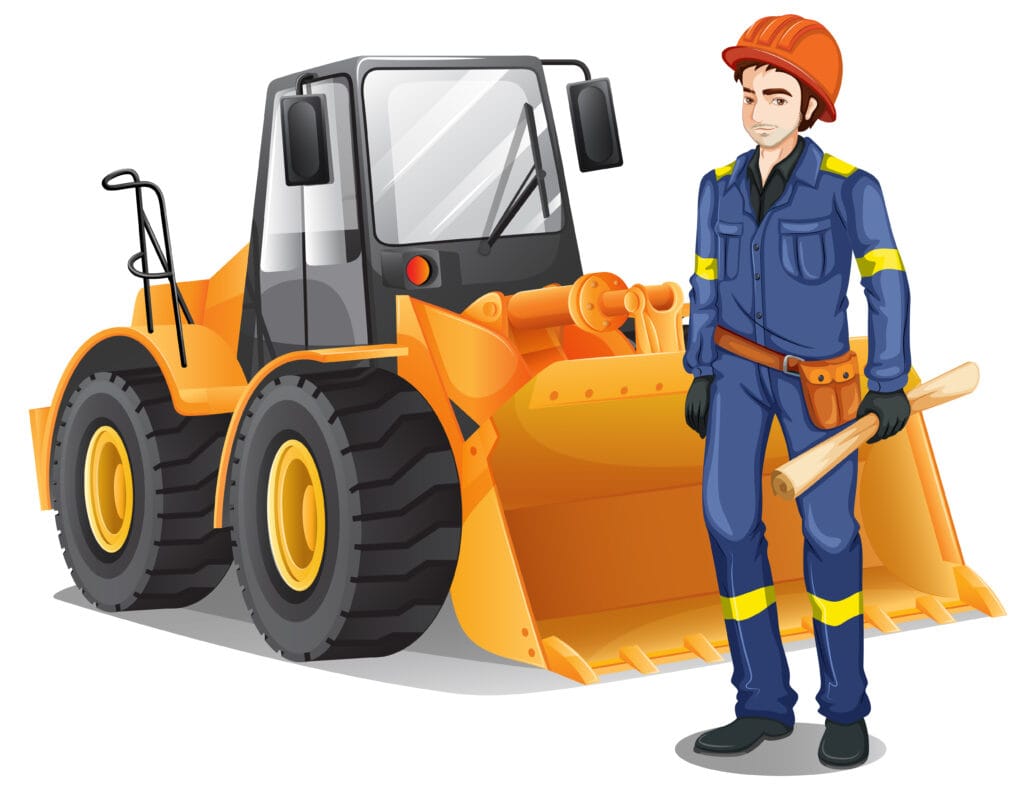Heavy-equipment operations come with unique challenges and risks that demand strict adherence to safety protocols. This article outlines essential guidelines to ensure operator safety during snow removal operations, covering everything from proper equipment use, personal protective equipment (PPE), Safety Kit essentials, pre-operation procedures, fatigue management, communication and training. By following these guidelines, operators can maintain safety, efficiency, and effectiveness during the harshest winter conditions.
Table of Contents
1. Adhering to Safe Operating Practices.
Safety should be a top priority to all heavy-equipment operators, and adhering to safe operating practices (such as avoiding overloading, ensuring clear visibility, maintaining appropriate speeds, and following established safety guidelines) is essential to minimize risks and near miss events hence preventing accidents and enhancing operator safety. These practices not only protect the operator but also enhance overall operational efficiency:

- Avoid Overloading: Operating an equipment beyond its capacity can compromise safety and lead to equipment damage. Operators should refrain from pushing excessive amounts of load (ice, snow) in a single pass, as this places undue stress on machinery and may result in unsafe conditions. Specifically, when using skid steer loaders, avoid applying excessive down pressure, which can cause the wheels to lift off the ground. Such actions increase the risk of damaging surrounding property and creating hazardous situations. Prioritizing proper load management ensures safer and more effective operations.
- Ensure Proper Visibility: Maintaining optimal visibility is essential for operator safety and safe operation of heavy equipment. Operators should take the following measures to ensure clear sightlines and awareness of their surroundings:
- Regularly clean windshields and mirrors, ensuring they remain free of ice, snow, mud, dust and other obstructions.
- Use windshield washer fluid to maintain clear visibility during operations.
- Verify that all lights, including headlights, taillights, and warning devices, are functioning correctly to enhance visibility for the operator and others.
- Exercise heightened caution, particularly when reversing, to identify and avoid pedestrians, vehicles, and other potential obstacles.
- Maintain Safe Speeds: Adapt your driving speed to match current road conditions, as reduced speeds are often essential for maintaining control and effectively responding to unforeseen hazards. Employ defensive driving strategies by staying vigilant for winter-specific risks such as black ice and other slippery surfaces that can compromise operator safety.
- Avoid Distracted Operation: Maintaining full attention during equipment operation is critical for operator safety and efficiency. Distractions, such as using mobile phones, engaging in non-essential conversations, or allowing the mind to wander, can significantly impair focus and reaction times. Operators should remain fully engaged with their surroundings, equipment controls, and tasks to prevent errors that may result in accidents. For example, when operating a snowplow, any lapse in focus can lead to misjudging obstacles, damaging property, or endangering bystanders. Prioritizing a distraction-free environment ensures operators can respond quickly to changing conditions and maintain safe, effective operations at all times.
2. Personal Protective Equipment (PPE).
Ensuring operator safety begins with the use of appropriate Personal Protective Equipment (PPE). Properly selected and maintained PPE not only safeguards operators from potential hazards but also enhances comfort and performance during operations. Recommended PPE includes the following:
- Hard Hat: Protects against falling objects and overhead hazards.
- Safety Glasses: Shields eyes from debris, glare, and other visual risks.
- Hearing Protection: Reduces exposure to excessive noise levels that can cause hearing damage.
- Gloves: Provides hand protection against cold, abrasions, and potential injuries.
- Water-Resistant Boots and Coats: Ensures dryness and warmth in wet and freezing conditions.
- Layered Clothing: Facilitates temperature regulation, enabling operators to adapt to varying weather conditions.

Complying to this PPE guideline is a critical step toward fostering a safe and efficient working environment in winter operations.
3. Safety Kit Essentials.
Safety kit essentials are non-negotiable when it comes to enhancing operator safety and ensuring efficient snow removal operations. Equipping snow removal machinery with a well-stocked safety kit significantly enhances operator preparedness, reduces risk, and promotes swift responses to unexpected challenges. Here’s why each component is vital:
- Reflective Gear: Boosts operator visibility, particularly in low-light conditions or areas with high vehicular activity, reducing the risk of accidents.
- Flashlight and Extra Batteries: Provides dependable illumination during emergencies or nighttime work, allowing operators to navigate and work safely in darkness.
- Ice Scraper or Snowbrush: Helps maintain clear visibility by quickly removing ice and snow from windshields and windows, essential for safe machine operation.
- First Aid Kit: Ensures minor injuries can be promptly addressed, minimizing disruptions and enhancing operator safety during shifts.
- Emergency Tools (Jumper Cables, Tow Rope): Prepares operators to handle unexpected machinery breakdowns or assist others, preventing prolonged downtime and ensuring continuous operation.
- Extra Gloves and Warm Clothing: Shields operators from extreme cold, maintaining comfort and dexterity during extended shifts in harsh winter conditions.
Investing in a comprehensive safety kit not only safeguards operators but also improves operational efficiency by minimizing disruptions and ensuring readiness for any situation.
4. Pre-Operation Procedures.
Undertaking pre-operation procedures is critical to ensuring operator safety, minimizing equipment damage, and optimizing efficiency during snow removal operations. By diligently following the preparatory steps below, you can significantly reduce the likelihood of accidents and ensure a smoother workflow in challenging winter conditions:
- Comprehensive Equipment Inspection.
- Verify that all fluids (e.g., engine oil, hydraulic fluid, coolant) are at proper levels to prevent breakdowns during operations.
- Ensure attachments such as plows and blowers are securely fastened and functioning correctly.
- Check the condition of tires or tracks to ensure maximum traction and stability.
- Inspect safety features, including lights, alarms, and mirrors, to guarantee their proper operation in low-visibility conditions.
- Familiarize Yourself with the Job Site.
- Study the site layout to identify potential hazards like hydrants, curbs, and drop-offs that could cause accidents.
- Develop a mental map of the site, factoring in areas requiring extra caution during snow removal.
- Indicate Hard-to-See Obstacles.
- Use flags, stakes, or reflective markers to clearly identify hidden obstacles such as utility access points, landscaping features, or uneven terrain.
- Proper marking helps avoid collisions and ensures efficient navigation throughout the operation.
These pre-operation procedures not only safeguard operators and equipment but also contribute to effective and timely snow removal. Investing time in preparation is an investment in safety, efficiency, and the overall success of your operation.
5. Fatigue Management.
Fatigue is a common challenge for operators during snow removal operations, where long hours and demanding conditions are the norm. Proper fatigue management is essential to enhance operator safety and reduce the risk of accidents. Here are proven guidelines to manage fatigue effectively:
- Take Scheduled Breaks.
- Plan regular rest intervals during shifts to allow operators time to recover physically and mentally.
- Short breaks can significantly improve alertness and decision-making, reducing the likelihood of errors caused by exhaustion.
- Stay Hydrated and Eat Nutritious Meals.
- Ensure operators consume sufficient water to prevent dehydration, which can impair concentration and energy levels.
- Encourage the intake of balanced meals and snacks to sustain consistent energy throughout the workday.
- Recognize and Respond to Fatigue Symptoms.
- Train operators to recognize early signs of fatigue, such as difficulty concentrating, slower reaction times, and frequent yawning.
- Encourage open communication so operators can promptly report fatigue symptoms to supervisors and seek adjustments to their workload if needed.
Implementing these fatigue management practices not only ensures operators are alert and responsive but also creates a safer working environment during snow removal operations.
6. Communication and Training.
Enhancing operator safety during snow removal operations relies heavily on effective communication and comprehensive training. Here are 6 proven steps to achieve this:
- Implement a Clear Communication System.
- Use well-defined communication tools such as two-way radios, signal protocols, or mobile apps to ensure seamless coordination among crew members.
- Establish standardized communication protocols to avoid misunderstandings, especially in challenging weather conditions.
- Provide Comprehensive Training.
- Organize thorough training programs that cover the proper operation of snow removal equipment, safety procedures, and how to handle winter-specific hazards like ice or low visibility.
- Include hands-on practice sessions to build operator confidence and skill
- Emphasize Hazard Awareness.
- Educate operators about common winter hazards such as black ice, snowdrifts, and slippery slopes.
- Teach situational awareness techniques to help operators anticipate and react effectively to potential dangers.
- Conduct Regular Safety Meetings.
- Schedule routine safety meetings to review best practices and address any emerging risks or operational challenges.
- Use these meetings as an open forum for operators to share concerns or suggest safety improvements.
- Update Training Based on Feedback.
- Gather input from operators during safety meetings or post-operation reviews to identify areas for improvement.
- Incorporate feedback into updated training modules to ensure relevance and effectiveness.
- Encourage a Safety-First Culture.
- Promote a workplace culture that prioritizes safety above speed or efficiency.
- Empower crew members to communicate openly about risks and to stop operations when safety is compromised.
By prioritizing clear communication and consistent training, you can significantly reduce accidents and ensure that snow removal operations are both safe and effective.
Conclusion.
Ensuring operator safety during snow removal operations is not just a compliance matter (it’s a critical responsibility that directly impacts the well-being of your team and the success of your operations). By adhering to these six guidelines, you can significantly reduce risks and improve operational efficiency.
As heavy-equipment operations present some of the most challenging conditions, prioritizing safety will not only protect your operators but also ensure smooth, uninterrupted operations. Equip your team with the right tools, knowledge, and practices to navigate this season safely and effectively. Safety isn’t just a guideline; it’s a commitment to excellence in every operation.

Ningo, founder of Big Machines Today, is a passionate writer and content creator specializing in heavy-duty machinery. Focused on delivering industry insights and trends, Ningo crafts engaging content for professionals. Open to free collaborations on blogs or social media articles, Ningo invites you to connect and explore the Big Machines Today Blog for valuable updates.
















[…] machinery in top condition. By implementing these measures, you’ll improve performance, enhance operator safety, and extend equipment lifespan, ensuring reliable operation throughout the harshest winter […]